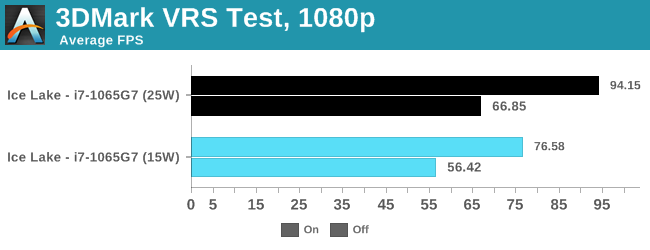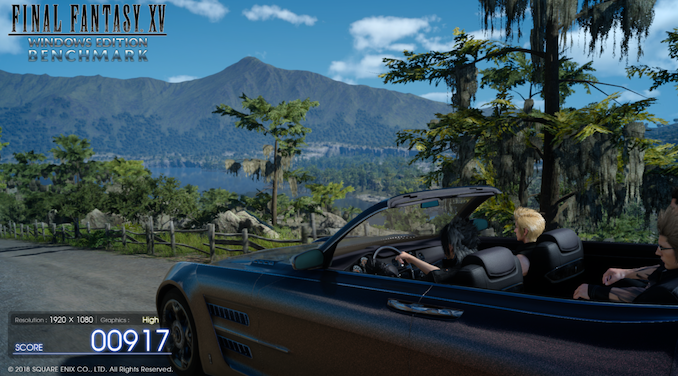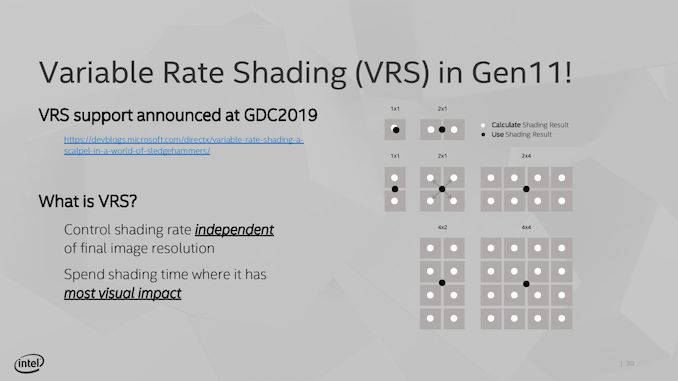The Ice Lake Benchmark Preview: Inside Intel's 10nm
by Dr. Ian Cutress on August 1, 2019 9:00 AM EST- Posted in
- CPUs
- Intel
- GPUs
- 10nm
- Core
- Ice Lake
- Cannon Lake
- Sunny Cove
- 10th Gen Core
Gaming Results (15W and 25W)
One of the biggest changes to the Ice Lake design is in the integrated graphics – Intel is now giving more focus and more die area to graphics, something it has arguably been neglecting for several years now. With Ice Lake, we move to a Gen11 graphics architecture, which is almost like the previous Gen9.5 but now with added support for variable rate shading (VRS), moving from 24 EUs to 64 EUs, and memory support up from LPDDR3-2133 to LPDDR4X-3733.


World of Tanks is a very CPU driven benchmark, and having the extra frequency of the 25W processor does help here. We're getting a sizeable uplift from Whiskey Lake, due to the extra EUs and memory frequency.


Our Final Fantasy test seemed to regress in 25W mode, although still within the noise. This test is still GPU bound, so adding the extra TDP to the CPU didn't actually help much. However, comparing to the Whiskey Lake integrated graphics, we've got over a 2x speedup.


Similarly with Civilization, with what is normally our 'IGP' settings, we are still GPU limited here.
One of Intel's newest features is Variable Rate Shading.
If developers add the option, soon to be an easy checkbox in Unity and Unreal, the game can decide to control the rate at which it shades pixels, from calculating every pixel down using one result across a 4x4 grid, to save compute power. Currently the only way to test this is with the 3DMark functional demo.

The new VRS test in 3DMark is designed as a feature test to show the potential uplift effect from enabling variable rate shading within a game. In both 15W and 25W modes, the data saw a good uplift, and we seemed to get more out of the 25W mode than the 15W mode.














261 Comments
View All Comments
Fulljack - Thursday, August 1, 2019 - link
lpddr4 would make it higher priced and stuck in premium device, as it's a soldered ram.RSAUser - Friday, August 2, 2019 - link
I think the commenter means DDR4L, low powered SO-DIMM and not the usual phone/tablet soldered RAM.Rudde - Thursday, August 1, 2019 - link
There are rumors (check AT forums) about a Gen 12 (ice lake is 11) discrete gpu with 512 EUs (arctic sound). I believe 64 EUs is confirmed max on Ice lake, but the generation after that (Tiger lake?) might have more.Mr Perfect - Thursday, August 1, 2019 - link
I notice that these parts all have Hyper threading. Has Intel addressed their security concerns with HT in Ice Lake, or do they see the benefits of HT to be greater then the risks in the mobile space?djayjp - Thursday, August 1, 2019 - link
And what about Zombieload...? Or was that just quietly swept under the rug?justaviking - Thursday, August 1, 2019 - link
QUOTE: "After attending the event, to which fewer than 10 press were invited, I now understand why. Some of the press invited didn’t have OS images, didn’t bring benchmarks with them, and were quite happy to go along with the flow. Intel provided benchmarks like Geekbench and 3DMark, which those press with their audiences were happy to run. I came prepared with both a new 1903 OS image and my benchmark suite, ready to rock and roll."And that is why we love AnandTech. :)
justaviking - Thursday, August 1, 2019 - link
And QUOTE: "It was clear that some of the press in attendance only needed a day (or half a day), but for what we do at AT, then two days would be better."Thank you for the article, and for doing the best you could in the time available.
ManDaddio - Thursday, August 1, 2019 - link
Well I'm glad that we got a little bit more looking to this part of Intel's 10nm. I'm looking forward to the next iteration to be honest.Actually I was more interested in the features of these new Intel laptops.
The benchmarks as you stated are just surface stuff until you can actually truly spend a while testing these things when they come out.
All the rave right now in some circles is AMD but I always liked Intel laptops for their features as well as performance.
And I have owned a couple AMD laptops. They were good and did the job but my Intel laptops were always much better. That's my experience.
I understand the challenges of putting an article like this out to the public who complains a lot or just wants to troll. Thanks for sharing.
Bulat Ziganshin - Thursday, August 1, 2019 - link
>AMD for Zen 2 decided to halve the L1-D, double increase the L1-D associativityit was L1-I cache
Drumsticks - Thursday, August 1, 2019 - link
In terms of pure performance, Icelake is definitely let down by it's available frequency. It's in bad need of a 10nm++ process or a backport to 14nm.It was a good idea to release it for laptops though, I think. Laptops definitely are about more than just the CPU, and the overall experience the Icelake featureset enables might actually be a good selling point.
I'd love to see an Icelake based microarchitecture released on Intel 14+++ though. Even though 14+++ has been around forever, I think it's still a good node. It's still completely untouched by any other node in frequency, power consumption isn't as important to desktop users, and the node must be so optimized by now that costs are good even with bigger dies.